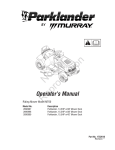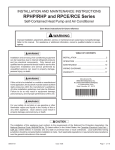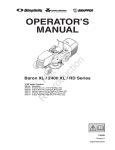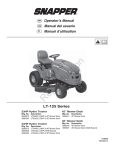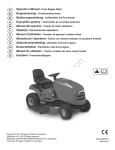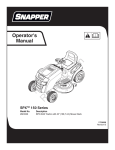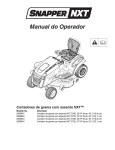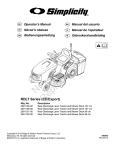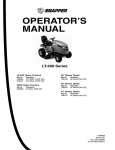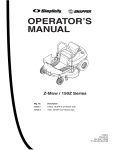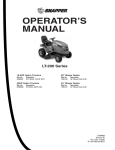Download Murray Parklander2690999 Operator`s manual
Transcript
R N ep o ro t fo du r ct io n Operator’s Manual MT125 Series Riding Mowers Hydro Tractors Mfg. No. Description 2691000 MT125, 17.5 Gross HP Hydro Tractor Mower Decks Mfg. No. Description 1696084 42” Mower Deck 1752627 Revision - TABLE OF CONTENTS CONTENTS Operator Safety.................................................................................................... 3 Features and Controls....................................................................................... 11 Operation............................................................................................................ 14 Safety Interlock System Tests........................................................................... 14 Maintenance....................................................................................................... 19 Troubleshooting................................................................................................. 25 Specifications..................................................................................................... 27 Parts and Accessories....................................................................................... 27 Warranties........................................................................................................... 28 General Information Thank you for purchasing this quality-built MURRAY PARKLANDER riding mower. We’re pleased that you’ve placed your confidence in the MURRAY PARKLANDER brand. When operated and maintained according to the instructions in this manual, your MURRAY PARKLANDER product will provide many years of dependable service. N ep o ro t fo du r ct io n This manual contains safety information to make you aware of the hazards and risks associated with mowers and how to avoid them. Because Briggs & Stratton Power Products Group, LLC does not necessarily know all the applications this mower could be used for, it is important that you read and understand these instructions. Save these original instructions for future reference. Product Identification Tag Product Identification Tag Model / Modéle / Model Serial / Sèrie / Serie xxxxxxxx xxxxxxxxxx R Briggs & Stratton Power Products Group, L.L.C. Milwaukee, WI 53201 USA Product Reference Data When contacting your authorized dealer for replacment parts, service, or information you MUST have these numbers. Record your model name/number, manufacturer’s identification numbers, and engine serial numbers in the space provided for easy access. These numbers can be found in the locations shown. PRODUCT Model Description Name/Number Data Unit MFG Number Unit SERIAL Number Mower Deck MFG Number Mower Deck SERIAL Number Dealer Name Date Purchased Engine Make Tractor ID Tag Reference Engine Type/Spec ENGINE Reference Data Engine Model Engine Code/Serial Number The Illustrated Parts List for this machine can be downloaded from www.parklands.net. Please provide model and serial number when ordering replacement parts. Manual Content Copyright © 2011 Briggs & Stratton Corporation. All rights reserved. No part of this material may be reproduced or transmitted in any form by any means without the express written permission of Briggs & Stratton Power Products Group, LLC. 2 OPERATOR SAFETY Important Safety Instructions SAVE THESE INSTRUCTIONS - This manual contains important instructions that should be followed during the initial set-up, the operation, and the maintenance of the equipment. Save these original instructions for future reference. Safety Symbols and Meanings WEAR EYE PROTECTION READ MANUAL KICKBACK EXPLOSION HAZARDOUS CHEMICAL FAST SHOCK SLOW STOP ON OFF FUEL SHUT-OFF HOT SURFACE OIL CHOKE FUEL AMPUTATION HAZARD ROLL-OVER HAZARD The safety alert symbol is used to identify safety information about hazards that can result in personal injury. A signal word (DANGER, WARNING, or CAUTION) is used with the alert symbol to indicate the likelihood and the potential severity of injury. In addition, a hazard symbol may be used to represent the type of hazard. en NOTICE indicates a situation that could result in damage to the product. WARNING The engine exhaust from this product contains chemicals known to the State of California to cause cancer, birth defects, or other reproductive harm. N ep o ro t fo du r ct io n TOXIC FUMES MOVING PARTS WARNING indicates a hazard which, if not avoided, could result in death or serious injury. CAUTION indicates a hazard which, if not avoided, could result in minor or moderate injury. R FIRE DANGER indicates a hazard which, if not avoided, will result in death or serious injury. WARNING Certain components in this product and its related accessories contain chemicals known to the State of California to cause cancer, birth defects, or other reproductive harm. Wash hands after handling. WARNING Battery posts, terminals, and related accessories contain lead and lead compounds - chemicals known to the State of California to cause cancer, birth defects, or other reproductive harm. Wash hands after handling. WARNING Running engine gives off carbon monoxide, an odorless, colorless, poison gas. Breathing carbon monoxide can cause headache, fatigue, dizziness, vomiting, confusion, seizures, nausea, fainting or death. • Operate equipment ONLY outdoors. • Keep exhaust gas from entering a confined area through windows, doors, ventilation intakes, or other openings. 3 OPERATOR SAFETY WARNING Fuel and its vapors are extremely flammable and explosive. Fire or explosion can cause severe burns. • Turn engine off and let engine cool at least 3 minutes before removing the fuel cap. • Fill fuel tank outdoors or in well-ventilated area. • Do not overfill fuel tank. To allow for expansion of the fuel, do not fill above the bottom of the fuel tank neck. • Keep fuel away from sparks, open flames, pilot lights, heat, and other ignition sources. • Check fuel lines, tank, cap, and fittings frequently for cracks or leaks. Replace if necessary When Starting Engine • Ensure that spark plug, muffler, fuel cap and air cleaner (if equipped) are in place and secured. • Do not crank engine with spark plug removed. • If engine floods, set choke (if equipped) to OPEN/ RUN position, move throttle (if equipped) to FAST position and crank until engine starts. When Operating Equipment • Keep hands and feet away from rotating parts. • Tie up long hair and remove jewelry. • Do not wear loose-fitting clothing, dangling drawstrings or items that could become caught. WARNING Rapid retraction of starter cord (kickback) will pull hand and arm toward engine faster than you can let go. Broken bones, fractures, bruises or sprains could result. N ep o ro t fo du r ct io n • If fuel spills, wait until it evaporates before starting engine. • Do not tip engine or equipment at angle which causes fuel to spill. • Do not choke the carburetor to stop engine. R • Never start or run the engine with the air cleaner assembly (if equipped) or the air filter (if equipped) removed. • If you drain the oil from the top oil fill tube, the fuel tank must be empty or fuel can leak out and result in a fire or explosion. When Transporting Equipment • Transport with fuel tank EMPTY or with fuel shut-off valve OFF. When Storing Fuel Or Equipment With Fuel In Tank • Store away from furnaces, stoves, water heaters or other appliances that have pilot lights or other ignition sources because they can ignite fuel vapors. 4 Rotating parts can contact or entangle hands, feet, hair, clothing, or accessories. Traumatic amputation or severe laceration can result. • Operate equipment with guards in place. When Adding Fuel When Changing Oil WARNING • When starting engine, pull the starter cord slowly until resistance is felt and then pull rapidly to avoid kickback. • Remove all external equipment/engine loads before starting engine. • Direct-coupled equipment components such as, but not limited to, blades, impellers, pulleys, sprockets, etc. must be securely attached. WARNING Running engines produce heat. Engine parts, especially muffler, become extremely hot. Severe thermal burns can occur on contact. Combustible debris, such as leaves, grass, brush, etc. can catch fire. • Allow muffler, engine cylinder and fins to cool before touching. • Remove accumulated debris from muffler area and cylinder area. • It is a violation of California Public Resource Code, Section 4442, to use or operate the engine on any forest-covered, brush-covered, or grass-covered land and unless the exhaust system is equipped with a spark arrester, as defined in Section 4442, maintained in effective working order. Other states or federal jurisdictions may have similar laws. Contact the origincal equipment manufacturer, re- tailer, or dealer to obtain a spark arrester designed for the exhaust system installed on this engine. OPERATOR SAFETY Operating Safety Power equipment is only as safe as the operator. If it is misused, or not properly maintained, it can be dangerous! Remember, you are responsible for your safety and that of those around you. Use common sense, and think through what you are doing. If you are not sure that the task you are about to perform can be safely done with the equipment you have chosen, ask a professional: contact your local authorized dealer. Read the Manual The operator’s manual contains important safety information you need to be aware of BEFORE you operate your unit as well as DURING operation. N ep o ro t fo du r ct io n Safe operating techniques, an explanation of the product’s features and controls, and maintenance information is included to help you get the most out of your equipment investment. R Be sure to completely read the Safety Rules and Information found on the following pages. Also completely read the Operation section. Children Reverse Tragic accidents can occur with children. Do not allow them anywhere near the area of operation. Children are often attracted to the unit and mowing activity. Never assume that children will remain where you last saw them. If there is a risk that children may enter the area where you are mowing, have another responsible adult watch them. Do not mow in reverse unless absolutely necessary. Always look down and behind before and while traveling in reverse even with the mower blades disengaged. DO NOT GIVE CHILDREN RIDES ON THIS UNIT! This encourages them to come near the unit in the future while it is running, and they could be seriously hurt. They may then approach the unit for a ride when you are not expecting it, and you may run over them. en 5 OPERATOR SAFETY Slope Operation You could be seriously injured or even killed if you use this unit on too steep an incline. Using the unit on a slope that is too steep or where you don’t have adequate traction can cause you to lose control or roll over. A good rule of thumb is to not operate on any slope you cannot back up (in 2-wheel drive mode). You should not operate on inclines with a slope greater than a 3.5 ft (1,5 m) rise over a 20.0 ft (6,0 m) length. Always drive up and down slopes: never cross the face. Also note that the surface you are driving on can greatly impact stability and control. Wet grass or icy pavement can seriously affect your ability to control the unit. If you feel unsure about operating the unit on an incline, don’t do it. It’s not worth the risk. Moving Parts N ep o ro t fo du r ct io n This equipment has many moving parts that can injure you or someone else. However, if you are seated in the seat properly, and follow all the rules in this book, the unit is safe to operate. The mower deck has spinning mower blades that can amputate hands and feet. Do not allow anyone near the equipment while it is running! To help you, the operator, use this equipment safely, it is equipped with an operatorpresent safety system. Do NOT attempt to alter or bypass the system. See your dealer immediately if the system does not pass all the safety interlock system tests found in this manual. Thrown Objects This unit has spinning mower blades. These blades can pick up and throw debris that could seriously injure a bystander. Be sure to clean up the area to be mowed BEFORE you start mowing. R Do not operate this unit without the entire grass catcher or discharge guard (deflector) in place. Also, do not allow anyone in the area while the unit is running! If someone does enter the area, shut the unit off immediately until they leave. Fuel and Maintenance Gasoline is extremely flammable. Its vapors are also extremely flammable and can travel to distant ignition sources. Gasoline must only be used as a fuel, not as a solvent or cleaner. It should never be stored any place where its vapors can build up or travel to an ignition source like a pilot light. Fuel belongs in an approved, plastic, sealed gas can, or in the tractor fuel tank with the cap securely closed. Spilled fuel needs to be cleaned up immediately. Proper maintenance is critical to the safety and performance of your unit. Be sure to perform the maintenance procedures listed in this manual, especially periodically testing the safety system. 6 OPERATOR SAFETY Read these safety rules and follow them closely. Failure to obey these rules could result in loss of control of unit, severe personal injury or death to you, or bystanders, or damage to property or equipment. This mowing deck is capable of amputating hands and feet and throwing objects. The triangle in text signifies important cautions or warnings which must be followed. General operation R N ep o ro t fo du r ct io n 1. Read, understand, and follow all instructions in the manual and on the unit before starting. 2. Do not put hands or feet near rotating parts or under the machine. Keep clear of the discharge opening at all times. 3. Only allow responsible adults, who are familiar with the instructions, to operate the unit (local regulations can restrict operator age). 4. Clear the area of objects such as rocks, toys, wire, etc., which could be picked up and thrown by the blade(s). 5. Be sure the area is clear of other people before mowing. Stop the unit if anyone enters the area. 6. Never carry passengers. 7. Do not mow in reverse unless absolutely necessary. Always look down and behind before and while travelling in reverse. 8. Never direct discharge material toward anyone. Avoid discharging material against a wall or obstruction. Material may ricochet back toward the operator. Stop the blade(s) when crossing gravel surfaces. 9. Do not operate the machine without the entire grass catcher, discharge guard (deflector), or other safety devices in place. 10.Slow down before turning. 11.Never leave a running unit unattended. Always disengage the PTO, set parking brake, stop engine, and remove keys before dismounting. 12.Disengage blades (PTO) when not mowing. Shut off engine and wait for all parts to come to a complete stop before cleaning the machine, removing the grass catcher, or unclogging the discharge guard. 13.Operate the machine only in daylight or good artificial light. 14.Do not operate the unit while under the influence of alcohol or drugs. 15 Watch for traffic when operating near or crossing roadways. 16.Use extra care when loading or unloading the unit into a trailer or truck. 17.Always wear eye protection when operating this unit. 18.Data indicates that operators, age 60 years and above, are involved in a large percentage of power equipmentrelated injuries. These operators should evaluate their ability to operate the equipment safely enough to protect themselves and others from injury. 19.Follow the manufacturer’s recommendations for wheel weights or counterweights. 20.Keep in mind the operator is responsible for accidents occurring to other people or property. 21.All drivers should seek and obtain professional and practical instruction. 22.Always wear substantial footwear and trousers. Never operate when barefoot or wearing sandals. 23.Before using, always visually check that the blades and blade hardware are present, intact, and secure. Replace worn or damaged parts. 24.Disengage attachments before: refueling, removing an attachment, making adjustments (unless the adjustment can be made from the operator’s position). 25.When the machine is parked, stored, or left unattended, lower the cutting means unless a positive mechanical lock is used. 26.Before leaving the operator’s position for any reason, engage the parking brake (if equipped), disengage the PTO, stop the engine, and remove the key. 27.To reduce fire hazard, keep the unit free of grass, leaves, & excess oil. Do not stop or park over dry leaves, grass, or combustible materials. 28.It is a violation of California Public Resource Code Section 4442 to use or operate the engine on or near any forest-covered, brush-covered, or grass-covered land unless the exhaust system is equipped with a spark arrester meeting any applicable local or state laws. Other states or federal areas may have similar laws. transporting and storage 1. When transporting the unit on an open trailer, make sure it is facing forward, in the direction of travel. If the unit is facing backwards, wind lift could damage the unit. 2. Always observe safe refueling and fuel handling practices when refueling the unit after transportation or storage. 3. Never store the unit (with fuel) in an enclosed poorly ventilated structure. Fuel vapors can travel to an ignition source (such as a furnace, water heater, etc.) and cause an explosion. Fuel vapor is also toxic to humans and animals. en 4. Always follow the engine manual instructions for storage preparations before storing the unit for both short and long term periods. 5. Always follow the engine manual instructions for proper start-up procedures when returning the unit to service. 6. Never store the unit or fuel container inside where there is an open flame or pilot light, such as in a water heater. Allow unit to cool before storing. 7 OPERATOR SAFETY Slope operation WARNING Never operate on slopes greater than 17.6 percent (10°) which is a rise of 3-1/2 feet (106 cm) vertically in 20 feet (607 cm) horizontally. When operating on slopes use additional wheel weights or counterweights. See your dealer/retailer to determine which weights are available and appropriate for your unit. Select slow ground speed before driving onto slope. In addition to front weights, use extra caution when operating on slopes with rear-mounted grass catchers. Mow UP and DOWN the slope, never across the face, use caution when changing directions and DO NOT START OR STOP ON SLOPE. Children Tragic accidents can occur if the operator is not alert to the presence of children. Children are often attracted to the unit and the mowing activity. Never assume that children will remain where you last saw them. 1. Keep children out of the mowing area and under the watchful care of another responsible adult. 2. Be alert and turn unit off if children enter the area. 3. Before and during reverse operation, look behind and down for small children. 4. Never carry children, even with the blade(s) off. They may fall off and be seriously injured or interfere with safe unit operation. Children who have been given rides in the past may suddenly appear in the mowing area for another ride and be run over or backed over by the machine. 5. Never allow children to operate the unit. 6. Use extra care when approaching blind corners, shrubs, trees, or other objects that may obscure vision. R N ep o ro t fo du r ct io n Slopes are a major factor related to loss-of-control and tipover accidents, which can result in severe injury or death. Operation on all slopes requires extra caution. If you cannot back up the slope or if you feel uneasy on it, do not operate on it. Control of a walk-behind or ride-on machine sliding on a slope will not be regained by the application of the brake. The main reasons for loss of control are: insufficient tire grip on the ground, speed too fast, inadequate braking, the type of machine is unsuitable for its task, lack of awareness of the ground conditions, incorrect hitching and load distribution. 1. Mow up and down slopes, not across. 2. Watch for holes, ruts, or bumps. Uneven terrain could overturn the unit. Tall grass can hide obstacles. 3. Choose a slow speed so that you will not have to stop or change speeds while on the slope. 4. Do not mow on wet grass. Tires may loose traction. 5. Always keep unit in gear especially when traveling down slopes. Do not shift to neutral and coast downhill. 6. Avoid starting, stopping, or turning on a slope. If tires lose traction, disengage the blade(s) and proceed slowly straight down the slope. 7. Keep all movement on slopes slow and gradual. Do not make sudden changes in speed or direction, which could cause the machine to rollover. 8. Use extra care while operating machines with grass catchers or other attachments; they can affect the stability of the unit. Do not use on steep slopes. 9. Do not try to stabilize the machine by putting your foot on the ground (ride-on units). 10.Do not mow near drop-offs, ditches, or embankments. The mower could suddenly turn over if a wheel is over the edge of a cliff or ditch, or if an edge caves in. 11.Do not use grass catchers on steep slopes. 12.Do not mow slopes if you cannot back up them. 13.See your authorized dealer/retailer for recommendations of wheel weights or counterweights to improve stability. 14.Remove obstacles such as rocks, tree limbs, etc. 15.Use slow speed. Tires may lose traction on slopes even through the brakes are functioning properly. 16.Do not turn on slopes unless necessary, and then, turn slowly and gradually downhill, if possible. TOwed Equipment (Ride-On Units) 1. Tow only with a machine that has a hitch designed for towing. Do not attach towed equipment except at the hitch point. 2. Follow the manufacturer’s recommendations for weight limit for towed equipment and towing on slopes. 3. Never allow children or others in or on towed equipment. 4. On slopes, the weight of the towed equipment may cause loss of traction and loss of control. 5. Travel slowly and allow extra distance to stop. 6. Do not shift to neutral and coast down hill. 8 Emissions 1. Engine exhaust from this product contains chemicals known, in certain quantities, to cause cancer, birth defects, or other reproductive harm. 2. Look for the relevant Emissions Durability Period and Air Index information on the engine emissions label. Ignition System 1. This spark ignition system complies with Canadian ICES-002. OPERATOR SAFETY Service and maintenance 13.If the fuel tank must be drained, it should be drained outdoors. 14.Replace faulty silencers/mufflers. 15.Use only factory authorized replacement parts when making repairs. 16.Always comply with factory specifications on all settings and adjustments. 17.Only authorized service locations should be utilized for major service and repair requirements. 18.Never attempt to make major repairs on this unit unless you have been properly trained. Improper service procedures can result in hazardous operation, equipment damage and voiding of manufacturer’s warranty. 19.On multiple blade mowers, take care as rotating one blade can cause other blades to rotate. 20.Do not change engine governor settings or over-speed the engine. Operating the engine at excessive speed can increase the hazard of personal injury. 21.Disengage drive attachments, stop the engine, remove the key, and disconnect the spark plug wire(s) before: clearing attachment blockages and chutes, performing service work, striking an object, or if the unit vibrates abnormally. After striking an object, inspect the machine for damage and make repairs before restarting and operating the equipment. 22.Never place hands near the moving parts, such as a hydro pump cooling fan, when the tractor is running. (Hydro pump cooling fans are typically located on top of the transaxle). 23.Units with hydraulic pumps, hoses, or motors: WARNING: Hydraulic fluid escaping under pressure may have sufficient force to penetrate skin and cause serious injury. If foreign fluid is injected into the skin it must be surgically removed within a few hours by a doctor familiar with this form of injury or gangrene may result. Keep body and hands away from pin holes or nozzles that eject hydraulic fluid under high pressure. Use paper or cardboard, and not hands, to search for leaks. Make sure all hydraulic fluid connections are tight and all hydraulic hoses and lines are in good condition before applying pressure to the system. If leaks occur, have the unit serviced immediately by your authorized dealer. 24.WARNING: Stored energy device. Improper release of springs can result in serious personal injury. Springs should be removed by an authorized technician. 25.Models equipped with an engine radiator: WARNING: Stored energy device. To prevent serious bodily injury from hot coolant or steam blow-out, never attempt to remove the radiator cap while the engine is running. Stop the engine and wait until it is cool. Even then, use extreme care when removing the cap. N ep o ro t fo du r ct io n Safe Handling of Gasoline 1. Extinguish all cigarettes, cigars, pipes, and other sources of ignition. 2. Use only approved gasoline containers. 3. Never remove the gas cap or add fuel with the engine running. Allow the engine to cool before refueling. 4. Never fuel the machine indoors. 5. Never store the machine or fuel container where there is an open flame, spark, or pilot light such as near a water heater or other appliance. 6. Never fill containers inside a vehicle or on a truck bed with a plastic bed liner. Always place containers on the ground away from your vehicle before filling. 7. Remove gas-powered equipment from the truck or trailer and refuel it on the ground. If this is not possible, then refuel such equipment on a trailer with a portable container, rather than from a gasoline dispenser nozzle. 8. Keep nozzle in contact with the rim of the fuel tank or container opening at all times until fueling is complete. Do not use a nozzle lock-open device. 9. If fuel is spilled on clothing, change clothing immediately. 10.Never over-fill the fuel tank. Replace gas cap and tighten securely. 11.Use extra care in handling gasoline and other fuels. They are flammable and vapors are explosive. 12.If fuel is spilled, do not attempt to start the engine but move the machine away from the area of spillage and avoid creating any source of ignition until fuel vapors have dissipated. 13.Replace all fuel tank caps and fuel container caps securely. R Service & Maintenance 1. Never run the unit in an enclosed area where carbon monoxide fumes may collect. 2. Keep nuts and bolts, especially blade attachment bolts, tight and keep equipment in good condition. 3. Never tamper with safety devices. Check their proper operation regularly and make necessary repairs if they are not functioning properly. 4. Keep unit free of grass, leaves, or other debris buildup. Clean up oil or fuel spillage. and remove any fuelsoaked debris. Allow machine to cool before storage. 5. If you strike an object, stop and inspect the machine. Repair, if necessary, before restarting. 6. Never make adjustments or repairs with the engine running. 7. Check grass catcher components and the discharge guard frequently and replace with manufacturer’s recommended parts, when necessary. 8. Mower blades are sharp. Wrap the blade or wear gloves, and use extra caution when servicing them. 9. Check brake operation frequently. Adjust and service as required. 10.Maintain or replace safety and instructions labels, as necessary. 11.Do not remove the fuel filter when the engine is hot as spilled gasoline may ignite. Do not spread fuel line clamps further than necessary. Ensure clamps grip hoses firmly over the filter after installation. 12.Do not use gasoline containing METHANOL, gasohol containing more than 10% ETHANOL, gasoline additives, or white gas because engine/fuel system damage could result. en 9 OPERATOR SAFETY Decal Locations Ignition Switch Positions Part No. 1722806 Danger, Main Panel Part No. 1734879 R Danger, Cut Hand/Foot Part No. 7101665 N ep o ro t fo du r ct io n Danger, Cut Hand/Foot Part No. 7101665 173xxxx Transmission Release Part No. 1730202 10 Height of Cut Part No. 1730264 Tractor Controls R N ep o ro t fo du r ct io n FEATURES AND CONTROLS Throttle/Choke Control (ChokeA-Matic) The throttle/choke controls the engine speed and choke (see Figure 1). Move the throttle/choke to the FAST position to increase engine speed and SLOW position to decrease engine speed. Always operate at full throttle. Move the throttle/choke control to the CHOKE position for starting a cold engine. A warm engine may not require choking. en Figure 1 Headlights The light switch turns the tractor headlights on and off. Hour Meter The hour meter measures the number of hours the key has been in the RUN position. 11 FEATURES AND CONTROLS Reverse Mowing Option (RMO) The Reverse Mowing Option allows for mowing (or use of other PTO driven attachments) while traveling in reverse. If you choose to mow in reverse, turn the RMO key after the PTO is engaged. The L.E.D. light will illuminate, and the operator can then mow in reverse. Each time the PTO is engaged the RMO needs to be reactivated if desired. PTO Switch The PTO (Power Take-Off) switch engages and disengages attachments that use the PTO. To engage the PTO, pull UP on the switch. Push DOWN to disengage. Note that the operator must be seated firmly in the tractor seat for the PTO to function. Ignition Switch OFF Stops the engine and shuts off the electrical system. RUN Allows the engine to run and powers the electrical system. START Cranks the engine for starting. NOTE: Never leave the ignition switch in the RUN position with the engine stopped–this drains the battery. Ground Speed Pedals R The tractor’s forward ground speed is controlled by the forward ground speed control pedal. The tractor’s reverse ground speed is controlled by the reverse ground speed control pedal. Depressing either pedal will increase ground speed. Note that the further down the pedal is depressed, the faster the tractor will travel. Cruise Control The cruise control is used to lock the ground speed control in forward. The cruise control has five lock positions. 12 The cutting height adjustment lever controls the mower cutting height. The cutting height is adjustable between 1.0” and 4.0” (2,5 and 10,2 cm). Seat Adjustment Lever The seat can be adjusted forward and back. Move the lever, position the seat as desired, and release the lever to lock the seat into position. Transmission Release Lever The transmission release lever deactivates the transmission so that the tractor can be pushed by hand. See Pushing the Tractor by Hand section. Fuel Tank To remove the cap, turn counterclockwise. N ep o ro t fo du r ct io n The ignition switch starts and stops the engine, it has three positions: Mower Height of Cut Adjustment Fuel Level Gauge Displays the fuel level in the tank. Parking Brake The parking brake knob is used to lock the parking brake when the tractor is stopped. Fully depressing the brake pedal and pulling up on the knob engages the parking brake. Brake Pedal Depressing the brake pedal applies the tractor brake. FEATURES AND CONTROLS Parking Brake Function Engage the Parking Brake - See Figure 2. To engage the parking brake, release the ground speed pedals (A), fully depress the brake pedal (B), pull UP on the parking brake knob (C), and then release brake pedal. Disengage the Parking Brake - See Figure 2. To disengage the parking brake, fully depress the brake pedal (B) and push the parking brake knob (C) DOWN. Cruise Control To engage: 1. Pull up on the cruise control knob (D, Figure 2). 2. Depress the forward ground speed pedal (A). 3. Lift up the cruise control knob (D) when desired speed is reached. The Cruise will lock in one of its five locking positions. To disengage: 1. Depress the brake pedal (B). or 2. Depress the forward ground speed pedal (A). B A D N ep o ro t fo du r ct io n C R Figure 2 en 13 OPERATION Safety Interlock System Tests This unit is equipped with a Safety Interlock System. Do not attempt to bypass or tamper with the switches and devices. WARNING If the unit does not pass a safety test, do not operate it. See an authorized dealer. Oil Recommendations We recommend the use of Briggs & Stratton Warranty Certified oils for best performance. Other high-quality detergent oils are acceptable if classified for service SF, SG, SH, SJ or higher. Do not use special additives. Outdoor temperatures determine the proper oil viscosity for the engine. Use the chart to select the best viscosity for the outdoor temperature range expected. Test 1 — Engine should NOT crank if: • PTO switch is ON, OR N ep o ro t fo du r ct io n • Brake pedal is fully depressed (parking brake ON), AND 49 38 27 15 4 -7 -18 -29 • The cruise control lever is in NEUTRAL. Test 3 — Engine should SHUT OFF if: • Operator rises off seat with PTO engaged, OR • Operator rises off seat with brake pedal NOT fully depressed (parking brake OFF). Test 4 — Check Mower Blade Stopping Time Mower blades and mower drive belt should come to a complete stop within five seconds after electric PTO switch is turned OFF. If mower drive belt does not stop within five seconds, see an authorized dealer. Test 5 — Reverse Mow Option (RMO) Check R • Engine should shut off if reverse travel is attempted if the PTO has been switched on and RMO has not been activated. • RMO light should illuminate when RMO has been activated. NOTE: Once the engine has stopped, the PTO switch must be turned off after the operator returns to the seat in order to start the engine. WARNING Mowing in reverse can be hazardous to bystanders. Tragic accidents can occur if the operator is not alert to the presence of children. Never activate the RMO if children are present. Children are often attracted to the unit and the mowing activity. 14 5W30 • PTO switch is OFF, AND °C 120 100 80 60 40 20 0 -20 Synthetic 5W30 Test 2 — Engine SHOULD crank if: °F 10W30 ** • The cruise control lever is NOT in NEUTRAL. Oil Recommendations SAE 30 * • Brake pedal is NOT fully depressed (parking brake OFF), OR * Below 40° F (4° C) the use of SAE 30 will result in hard starting. ** Above 80° F (27° C) the use of 10W30 may cause increased oil consumption. Check oil level more frequently. Oil Pressure If the oil pressure is too low, a pressure switch (if equipped) will either stop the engine or activate a warning device on the equipment. If this occurs, stop the engine and check the oil level with the dipstick. If the oil level is below the ADD mark, add oil until it reaches the FULL mark. Start the engine and check for proper pressure before continuing to operate. If the oil level is between the ADD and FULL marks, do not start the engine. Contact an authorized dealer to have the oil pressure problem corrected. OPERATION Check and Add Engine Oil 1. Place the tractor on a level surface. 2. Stop the engine. N ep o ro t fo du r ct io n 3. Clean the oil fill area of any debris and remove. 4. Remove the dipstick and wipe with a clean cloth (see Figures 3 and 4). 5. Fully insert the dipstick. 6. Remove the dipstick and check the oil level. It should be at the FULL mark on the dipstick. 7. If FULL, insert the dipstick and tighten securely. If LOW, add oil slowly into the engine oil fill (see Oil Recommendations). Do not overfill. After adding oil, wait one minute, then check the oil level. Figure 4 Fuel Recommendations Fuel must meet these requirements: • Clean, fresh, unleaded gasoline. • A minimum of 87 octane/87 AKI (91 RON). •Gasoline with up to 10% ethanol (gasohol) or up to 15% MTBE (methyl tertiary butyl ether) is acceptable. R CAUTION: Do not use unapproved gasolines, such as E85. Do not mix oil in gasoline or modify the engine to run on alternate fuels. This will damage the engine components and void the engine warranty. To protect the fuel system from gum formation, mix a fuel stabilizer into the fuel. See the Storage section. All fuel is not the same. If starting or performance problems occur, change fuel providers or change brands. This engine is certified to operate on gasoline. The emissions control system for this engine is EM (Engine Modifications). Figure 3 en 15 OPERATION Adding Fuel Starting the Engine WARNING Fuel and its vapors are extremely flammable and explosive. Fire or explosion can cause severe burns or death. 1. Clean the fuel cap area of dirt and debris. Remove the fuel cap (A, Figure 5). Also see Features and Controls section. 2. Fill the fuel tank (B) with fuel. To allow for expansion of the fuel, do not fill above the bottom of the fuel tank neck (C). A B WARNING uel and its vapors are extremely flammable and F explosive. Fire or explosion can cause severe burns or death. When Starting Engine • Ensure that spark plug, muffler, fuel cap, and air cleaner (if equipped) are in place and secured. • Do not crank engine with spark plug removed. • If engine floods, set choke (if equipped) to OPEN/RUN position, move throttle (if equipped) to FAST position and crank until engine starts. WARNING Engines give off carbon monoxide, an odorless, colorless, poison gas. Breathing carbon monoxide can cause nausea, fainting, or death. Fire or explosion can cause severe burns or death. • Start and run engine outdoors. •Do not start or run engine in enclosed area, even if doors or windows are open. 1. Check the oil level. See the Check and Add Engine Oil. 2. Make sure equipment drive controls, if equipped, are disengaged. 3. Turn the fuel shut-off valve, if equipped, to the ON position. 4. Move the throttle control to the FAST position. Operate the engine in the FAST position. R 3. Reinstall the fuel cap. N ep o ro t fo du r ct io n When Adding Fuel • Turn engine off and let engine cool at least 3 minutes before removing the fuel cap. • Fill fuel tank outdoors or in well-ventilated area. • Do not overfill fuel tank. To allow for expansion of the fuel, do not fill above the bottom of the fuel tank neck. • Keep fuel away from sparks, open flames, pilot lights, heat, and other ignition sources. • Check fuel lines, tank, cap, and fittings frequently for cracks or leaks. Replace if necessary. • If fuel spills, wait until it evaporates before starting engine. 5. Move the choke control, or the combination choke/ throttle lever, to the choke position. C Figure 5 NOTE: Choke is usually unnecessary when restarting a warm engine. 6. Turn the electric start switch to the on/start position. NOTE: If the engine does not start after repeated attempts, go to BRIGGSandSTRATTON.COM or call 1-800-233-3723 (in USA). NOTICE: To extend the life of the starter, use short starting cycles (five seconds maximum). Wait one minute between starting cycles. 7. As the engine warms up, move the choke control to the run position. 16 OPERATION Driving the Tractor Reverse Mowing Option (RMOTM) 1. Sit in the seat and adjust the seat so that you can comfortably reach all the controls and see the dashboard display. 2. Engage the parking brake. 3. Make sure the PTO switch is disengaged. 4. Start the engine (see Starting the Engine). 5. Disengage the parking brake and release the brake pedal. 6. Depress the forward ground speed control pedal to travel forward. Release the pedal to stop. Note that the further down the pedal is depressed the faster the tractor will travel. Mowing 1. Set the mower cutting height to the desired level using the mower lift lever. 2. Engage the parking brake. Make sure the PTO switch is disengaged. 3. Start the engine (see Starting the Engine). 4. Set the throttle to FULL. 5. Engage the PTO to activate the mower blades. 6. Begin mowing. The Reverse Mowing Option (RMO) allows the operator to mow in reverse (see Features and Controls). To activate, turn the RMO key after the PTO is engaged. The L.E.D. light will illuminate, and the operator can then mow in reverse. Each time the PTO is engaged the RMO needs to be reactivated if desired. The key should be removed to restrict access to the RMO. Pushing the Tractor by Hand 1. Disengage the PTO and turn the engine off (see Features and Controls). N ep o ro t fo du r ct io n 7. Stop the tractor by releasing the ground speed control pedals, setting the parking brake, and stopping the engine (see Stopping the Tractor and Engine). WARNING Mowing in reverse can be hazardous to bystanders. Tragic accidents can occur if the operator is not alert to the presence of children. Never activate the RMO if children are present. Children are often attracted to the unit and the mowing activity. 2. Pull out the lever approximately 2-3/8" (6 cm) to release the transmission (see Figure 6). 3. The tractor can now be pushed by hand. WARNING Towing the unit will cause transmission damage. Do not use another vehicle to push or pull this unit. Do not actuate the transmission release lever while the engine is running. 7. When finished, shut off the PTO and raise the deck using the mower lift lever. R 8. Stop the engine (see Stopping the Tractor and Engine). WARNING The engine will shut off if the reverse ground speed pedal is depressed while the PTO is on and the RMO has not been activated. The operator should always turn the PTO off prior to driving across on roads, paths, or any area that may be used by other vehicles. Sudden loss of drive could create a hazard. 17 30 20 2 Figure 6 en 17 OPERATION Adjusting Mower Cutting Height The cutting height adjustment lever (A, Figure 7) controls the mower cutting height. The cutting height is adjustable between approximately 1.0” and 4.0” (2,5 and 10,2 cm). Move the lever back to raise the deck and forward to lower it. Stopping the Tractor and Engine WARNING Fuel and its vapors are extremely flammable and explosive. Fire or explosion can cause severe burns or death. • Do not choke the carburetor to stop the engine. 1. Move the throttle control to the SLOW position. Turn the key switch to the OFF position. Remove the key and keep in a safe place out of the reach of children. 2. After the engine stops, turn the fuel shut-off valve, if equipped, to the closed position. A Attaching a Trailer N ep o ro t fo du r ct io n Figure 7 The maximum horizontal drawbar force allowed is 280 Newton. The maximum vertical drawbar force is 160 Newton. This equates to a 250 lbs (113 kg) trailer on a 10 degree hill. Secure the trailer with an appropriately sized clevis pin (A, Figure 8) and clip (B). A R B 18 Figure 8 MAINTENANCE Maintenance Chart TRACTOR AND MOWER ENGINE Every 8 Hours or Daily First 5 Hours Check safety interlock system Clean debris off tractor and mower deck Clean debris from engine compartment Every 25 Hours or Annually * Check tire pressure Check mower blade stopping time Check tractor and mower for loose hardware Every 50 Hours or Annually * Clean battery and cables Check engine oil level Every 25 Hours or Annually * Clean engine air filter and pre-cleaner ** Every 50 Hours or Annually * Change engine oil Replace oil filter Replace air filter Replace pre-cleaner See Dealer Annually to See Dealer Annually to N ep o ro t fo du r ct io n Check mower blades ** Every 8 Hours or Daily Annually Check tractor brakes Lubricate tractor and mower Change engine oil Inspect muffler and spark arrester * Whichever comes first **Check blades more often in regions with sandy soils or high dust conditions. Replace spark plug Replace fuel filter Clean engine air cooling system * Whichever comes first **Clean more often in dusty conditions or when airborne debris is present. R WARNING Unintentional sparking can result in fire or electric shock. Unintentional start-up can result in entanglement, traumatic amputation, or laceration. Before performing adjustments or repairs: •Disconnect the spark plug wire and keep it away from the spark plug. •Disconnect battery at negative terminal (only engines with electric start). • Use only correct tools. •Do not tamper with governor spring, links, or other parts to increase engine speed. •Replacement parts must be of the same design and installed in the same position as the original parts. Other parts may not perform as well, may damage the unit, and may result in injury. •Do not strike the flywheel with a hammer or hard object because the flywheel may shatter during operation. en Emissions Control Maintenance, replacement, or repair of the emissions control devices and systems may be performed by any nonroad engine repair establishment or individual. However, to obtain “no charge” emissions control service the work must be performed by a factory authorized dealer. See the Emissions Warranty. Check Mower Blade Stopping Time WARNING If the mower blade does not come to a complete stop within 5 seconds, the blade must be adjusted. Do not operate the machine until the proper adjustment has been performed by an authorized dealer. Check the mower blade for proper function (see Safety Interlock System Tests). The blade should stop rotating in 5 seconds or less after moving the blade control to the OFF position. 19 MAINTENANCE Check Tire Pressure Tire pressure should be checked periodically, and maintained at the levels shown in the chart. Note that these pressures may differ slightly from the “Max Inflation” stamped on the side-wall of the tires. The pressures shown provide proper traction, improve cut quality, and extend tire life. 5. Clean the battery compartment with a solution of baking soda and water. 6. Clean the battery terminals and cable ends with a wire brush and battery terminal cleaner until shiny. 7. Reinstall the battery in the battery compartment. Secure with the battery hold-down rod and wingnut and washer. 8. Re-attach the battery cables, positive cables and cover first then the negative cables. 9. Coat the cable ends and battery terminals with petroleum jelly or non-conducting grease. Size PSI bar 15 x 6.0-6 12-14 0,82-0,96 bar 10 Battery Maintenance 0,68 bar N ep o ro t fo du r ct io n 20 x 10.0-8 R Battery posts, terminals, and related accessories contain lead and lead compounds - chemicals known to the State of California to cause cancer, birth defects, or other reproductive harm. Wash hands after handling. Cleaning the Battery and Cables 1. Disconnect the cables from the battery, negative cables first (A, Figure 9) then the cover and positive cables (B). 2. Loosen the wingnut and washer (D). 3. Pivot the hold-down rod (C) up and away from battery. Secure to steering tower. 4. Remove the battery (E). 20 B C WARNING When removing or installing battery cables, disconnect the negative cable FIRST and reconnect it LAST. If not done in this order, the positive terminal can be shorted to the frame by a tool. WARNING A D E Figure 9 Charging the Battery WARNING Keep open flames and sparks away from the battery; the gasses coming from it are highly explosive. Ventilate the battery well during charging. A dead battery or one too weak to start the engine may be the result of a defect in the charging system or other electrical component. If there is any doubt about the cause of the problem, see your dealer. If you need to replace the battery, see the Cleaning the Battery and Cables section. To charge the battery, follow the instructions provided by the battery charger manufacturer as well as all warnings included in the Operator Safety section of this manual. Charge the battery until fully charged. Do not charge at a rate higher than 10 amps. MAINTENANCE Changing the Engine Oil WARNING Fuel and its vapors are extremely flammable and explosive. Fire or explosion can cause severe burns or death. When Changing Oil •If you drain the oil from the top oil fill tube, the fuel tank must be empty or fuel can leak out and result in a fire or explosion. Run engine until warm. Place the tractor on a level surface. Stop the engine. Clean oil fill and filter areas of any debris. Remove dipstick and lay on clean cloth (see Figures 3 and 4). 5. Disconnect the oil drain hose (see Figure 10). Carefully remove cap and lower hose into an approved container. After the oil has drained, install cap tightly, then attach the hose to the side of the engine. 6. Remove the oil filter and dispose of properly. Figure 11 R N ep o ro t fo du r ct io n 1. 2. 3. 4. Figure 10 7. Lightly lubricate the oil filter gasket with fresh, clean oil (see Figures 11 and 12). 8. Install the oil filter by hand until the gasket contacts the oil filter adapter, then tighten the oil filter 1/2 to 3/4 turns. 9. Add oil (see Check and Add Engine Oil). en Figure 12 21 MAINTENANCE Servicing the Air Filter 6. Assemble the dry pre-cleaner to the filter. WARNING Fuel and its vapors are extremely flammable and explosive. Fire or explosion can cause severe burns or death. • Never start or run the engine with the air cleaner assembly or air filter removed. 7. Install the filter on the intake. Push the end of the filter into the base as shown. Make sure filter fits securely in the base. 8. Install air filter cover and secure with fasteners. NOTE: Replace pre-cleaner/cartridge when dirty or damaged. NOTICE: Do not use pressurized air or solvents to clean the filter. Pressurized air can damage the filter and solvents will dissolve the filter. IntekTM Single Cylinder Engines 1. Remove the fasteners (A, Figure 13) and the air filter cover (B). N ep o ro t fo du r ct io n 2. To remove the filter (C), lift the end of the filter and then pull the filter off the intake (D). 3. Remove the pre-cleaner (E), if equipped, from the filter. 4. To loosen debris, gently tap the filter on a hard surface. If the filter is excessively dirty, replace with a new filter. 5. Wash the pre-cleaner in liquid detergent and water. Then allow it to thoroughly air dry. Do not oil the pre- cleaner. B R A C D E Figure 13 22 MAINTENANCE Servicing the Spark Plug Servicing the Muffler WARNING Unintentional sparking can result in fire or electric shock. Unintentional start-up can result in entanglement, traumatic amputation, or laceration. WARNING Running engine produces heat. Engine parts, especially muffler, become extremely hot. Severe thermal burns can occur on contact. Combustible debris, such as leaves, grass, brush, etc. can catch fire. •Allow muffler, engine cylinder and fins to cool before touching. • Remove visible debris from engine compartment. When testing for spark: • Use approved spark plug tester. • Do not check for spark with spark plug removed. CAUTION: Spark plugs have different heat ranges. It is important that the correct spark plug is used, otherwise, engine damage can occur. To service the muffler, see an authorized dealer. N ep o ro t fo du r ct io n Clean Spark Plug Clean with wire brush and sturdy knife. Do NOT use abrasives. WARNING Replacement parts must be the same position as the original parts or fire could result. Check Spark Plug Gap Use a spark plug feeler gauge to check the gap between the two electrodes. When the gap is correct, the gauge will drag slightly as you pull it through the gap. If necessary, use the spark plug gauge to adjust the gap by gently bending the curved electrode without touching the center electrode or the porcelain. Seat Adjustment The seat can also be adjusted forward and back. Move the lever (A, Figure 14), position the seat as desired, and release the lever to lock the seat into position. A R .030˝ (0.76 mm) Install Spark Plug Finger tighten, then tighten with wrench. • 180 in-lbs (20 Nm), OR •1/2 turn when reinstalling the original spark plug. 1/4 turn when installing a new spark plug. en Figure 14 23 MAINTENANCE Storage WARNING Never store the unit (with fuel) in an enclosed, poorly ventilated structure. Fuel vapors can travel to an ignition source (such as a furnace, water heater, etc.) and cause an explosion. Fuel vapor is also toxic to humans and animals. When Storing Fuel Or Equipment With Fuel In Tank • Store away from furnaces, stoves, water heaters or other appliances that have pilot lights or other ignition sources because they can ignite fuel vapors. Equipment Disengage the PTO, set the parking brake, and remove the key. Battery life will be increased if it is removed. Put in a cool, dry place and fully charged about once a month. If the battery is left in the unit, disconnect the negative cable. N ep o ro t fo du r ct io n Fuel System Fuel can become stale when stored over 30 days. Stale fuel causes acid and gum deposits to form in the fuel system or on essential carburetor parts. To keep fuel fresh, use Briggs & Stratton FRESH START® fuel stabilizer, available as a liquid additive or a drip concentrate cartridge. There is no need to drain gasoline from the engine if a fuel stabilizer is added according to instructions. Run the engine for 2 minutes to circulate the stabilizer throughout the fuel system. The engine and fuel can then be stored up to 24 months. R If gasoline in the engine has not been treated with a fuel stabilizer, it must be drained into an approved container. Run the engine until it stops from lack of fuel. The use of a fuel stabilizer in the storage container is recommended to maintain freshness. Engine Oil While the engine is still warm, change the engine oil. See Engine Manual. Before starting the unit after it has been stored: • Check all fluid levels. Check all maintenance items. • Perform all recommended checks and procedures found in this manual. • Allow the engine to warm up for several minutes before use. 24 TROUBLESHOOTING Troubleshooting the Tractor Engine starts hard or runs poorly. Engine knocks. Excessive oil consumption. Engine exhaust is black. Fully depress brake pedal. Place in OFF position. REMEDY Cruise control engaged. Move knob to NEUTRAL/OFF position. Out of fuel. If engine is hot, allow it to cool, then refill the fuel tank. Engine flooded. Disengage the choke. Fuse is blown. See authorized dealer. Battery terminals require cleaning. See Cleaning the Battery and Cables section. Battery discharged or dead. Recharge or replace battery. Wiring loose or broken. Visually check wiring. If wires are frayed or broken, see authorized dealer. Solenoid or starter motor faulty. Safety interlock switch faulty. Water in fuel. See authorized dealer. Gas is old or stale. See authorized dealer. Fuel mixture too rich. Clean air filter. Engine has other problem. See authorized dealer. Low oil level. Check/add oil as required. Using wrong grade oil. See Oil Recommendations section. Engine running too hot. See authorized dealer. Using wrong grade oil. See Oil Recommendations section. Too much oil in crankcase. Drain excess oil. Dirty air filter. Replace air filter. Choke closed. Open choke. N ep o ro t fo du r ct io n Engine will not turnover or start. LOOK FOR Brake pedal not depressed. PTO (electric clutch) switch is in ON position. R PROBLEM See authorized dealer. See authorized dealer. Ground speed control pedals Depress pedals. not depressed. Transmission release lever Engine runs, but tractor will in PUSH position. not drive. Parking brake is engaged. Move into DRIVE position. Disengage parking brake. Traction drive belt is broken See authorized dealer. or slipping. en 25 TROUBLESHOOTING Troubleshooting the Tractor (Continued) PROBLEM Brake will not hold. Tractor steers hard or handles poorly. LOOK FOR Internal brake worn. See authorized dealer. REMEDY Steering linkage is loose. See authorized dealer. Improper tire inflation. See Check Tire Pressure section. Front wheel spindle bearings See authorized dealer. dry. Troubleshooting the Mower PROBLEM Mower will not raise. LOOK FOR Lift linkage not properly attached or damaged. REMEDY See authorized dealer. Mower not leveled properly. See authorized dealer. Mower cut is rough looking. See Check Tire Pressure section. Engine speed too slow. Set to full throttle. Ground speed too fast. Slow down. Mower has other problem. See authorized dealer. Engine speed too slow. Set to full throttle. Ground speed to fast. Slow down. Dirty or clogged air filter. Replace air filter. Cutting height set too low. Cut tall grass at maximum cutting height during first pass. Engine not up to operating temperature. Run engine for several minutes to warm-up. R Engine stalls easily with mower engaged. Tractor tires not properly inflated. N ep o ro t fo du r ct io n Mower cut is uneven. Starting mower in tall grass. Start the mower in a cleared area. Excessive mower vibration. Mower has other problem. Engine runs and tractor drives, but mower will not drive. 26 See authorized dealer. PTO not engaged. Engage the PTO. Mower has other problem. See authorized dealer. SPECIFICATIONS ENGINE TRANSMISSION 17.5 Gross HP* Briggs & Stratton CHASSIS Fuel Tank Capacity Front Wheels Rear Wheels Power Rating Intek SeriesTM 17.5 HP @ 3500 +/- 100 rpm 30.5 cu in. (500 cc) Alternator: 9A Reg. Battery: 12 Volt, 230 CCA 48 oz (1,4 L) Capacity: 3.5 gal (13,2 L) Tire Size: 15 x 6,0-6 Inflation Pressure: 12-14 psi (0,82-0,96 bar) Tire Size: 20 x 10,0-8 Inflation Pressure: 10 psi (0,68 bar) Hydro-Gear T2HP 10w 30 Premium Engine Oil Forward: 0-5.6 MPH (0-9,0 km/h) Reverse: 0-3.5 MPH (0-5,6 km/h) 170 ft-lbs (230,5 Nm) Mower 42” Mower Deck: Width of Cut 42” (106,7 cm) Number of Blades2 Base Deck Platform Side Discharge Cutting Height 1.0-4.0 in. (2,5-10,2 cm) (Approx.) Cutting Positions7 N ep o ro t fo du r ct io n Model Horsepower Displacement Electrical System Oil Capacity Type Engine Oil Speeds @ 3400 rpm Continuous Torque Output R The gross power rating for individual gas engine models is labeled in accordance with SAE (Society of Automotive Engineers) code J1940 (Small Engine Power & Torque Rating Procedure), and rating performance has been obtained and corrected in accordance with SAE J1995 (Revision 2002-05). Torque values are derived at 3060 RPM; horsepower values are derived at 3600 RPM. Net power values are taken with exhaust and air cleaner installed whereas gross power values are collected without these attachments. Actual gross engine power will be higher than net engine power and is affected by, among other things, ambient operating conditions and engine-to-engine variability. Given the wide array of products on which engines are placed, the gas engine may not develop the rated gross power when used in a given piece of power equipment. This difference is due to a variety of factors including, but not limited to, the variety of engine components (air cleaner, exhaust, charging, cooling, carburetor, fuel pump, etc.), application limitations, ambient operating conditions (temperature, humidity, altitude), and engine-to-engine variability. Due to manufacturing and capacity limitations, Briggs & Stratton may substitute an engine of higher rated power for this Series engine. PARTS AND ACCESSORIES See an authorized dealer for parts and accessories. en 27 WARRANTIES Briggs & Stratton Power Products Group, L.L.C. Owner Warranty Policy Limited Warranty Briggs & Stratton Power Products Group, LLC will repair and/or replace, free of charge, any part(s) of the equipment that is defective in material or workmanship or both. Briggs & Stratton Corporation will repair and/or replace, free of charge, any part(s) of the Briggs & Stratton engine* (if equipped) that is defective in material or workmanship or both. Transportation charges on product submitted for repair or replacement under this warranty must be borne by purchaser. This warranty is effective for the time periods and subject to the conditions stated below. For warranty service, find the nearest Authorized Service Dealer using our dealer locator at www.BriggsandStratton.com . There is no other express warranty. Implied warranties, including those of merchantability and fitness for a particular purpose, are limited to one year from purchase or to the extent permitted by law. Liability for incidental or consequential damages are excluded to the extent exclusion is permitted by law. Some states or countries do not allow limitations on how long an implied warranty lasts, and some states or countries do not allow the exclusion or limitation of incidental or consequential damages, so the above limitation and exclusion may not apply to you. This warranty gives you specific legal rights and you may also have other rights which vary from state to state or country to country. Warranty Period N ep o ro t fo du r ct io n ItemConsumer UseCommercial Use Equipment 2 Years N/A Engine* 1 Year N/A The warranty period begins on the date of purchase by the first retail consumer or commercial end user, and continues for the period of time stated above. “Consumer use” means personal residential household use by a retail consumer. “Commercial use” means all other uses, including use for commercial, income producing or rental purposes. Once product has experienced commercial use, it shall thereafter be considered as commercial use for purposes of this warranty. No warranty registration is necessary to obtain warranty on Briggs & Stratton products. Save your proof of purchase receipt. If you do not provide proof of the initial purchase date at the time warranty service is requested, the manufacturing date of the product will be used to determine warranty eligibility. About Your Warranty R We welcome warranty repair and apologize to you for being inconvenienced. Warranty service is available only through servicing dealers authorized by Briggs & Stratton or BSPPG, LLC. Most warranty repairs are handled routinely, but sometimes requests for warranty service may not be appropriate. This warranty only covers defects in materials or workmanship. It does not cover damage caused by improper use or abuse, improper maintenance or repair, normal wear and tear, or stale or unapproved fuel. Improper Use and Abuse - The proper, intended use of this product is described in the Operator’s Manual. Using the product in a way not described in the Operator’s Manual or using the product after it has been damaged will void your warranty. Warranty is not allowed if the serial number on the product has been removed or the product has been altered or modified in any way, or if the product has evidence of abuse such as impact damage, or water/chemical corrosion damage. Improper Maintenance or Repair - This product must be maintained according to the procedures and schedules provided in the Operator’s Manual, and serviced or repaired using genuine Briggs & Stratton parts. Damage caused by lack of maintenance or use of non-original parts is not covered by warranty. Normal Wear - Like all mechanical devices, your unit is subject to wear even when properly maintained. This warranty does not cover repairs when normal use has exhausted the life of a part or the equipment. Maintenance and wear items such as filters, belts, cutting blades, and brake pads (engine brake pads are covered) are not covered by warranty due to wear characteristics alone, unless the cause is due to defects in material or workmanship. Stale Fuel - In order to function correctly, this product requires fresh fuel that conforms to the criteria specified in the Operator’s Manual. Damage caused by stale fuel (carburetor leaks, clogged fuel tubes, sticking valves, etc) is not covered by warranty. * Applies to Briggs & Stratton engines only. Warranty coverage of non-Briggs & Stratton engines is provided by the engine manufacturer. 28 N ep o ro t fo du r ct io n R WARRANTIES en 29 N ep o ro t fo du r ct io n R NOTES 30 N ep o ro t fo du r ct io n R NOTES en 31 N ep o ro t fo du r ct io n R Parklands Power Products (Aust) Pty Ltd. 106 Belmore Road-Riverwood 2210 New South Wales Australia 02 9584 7700 www.parklands.net
































